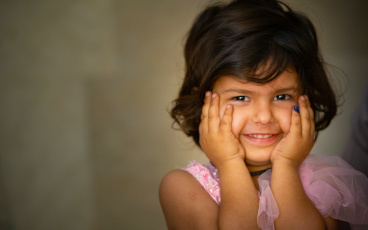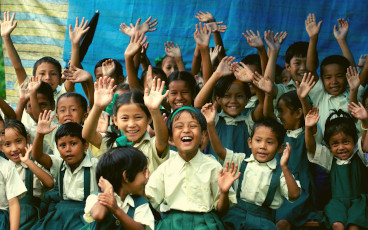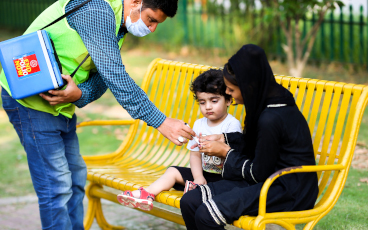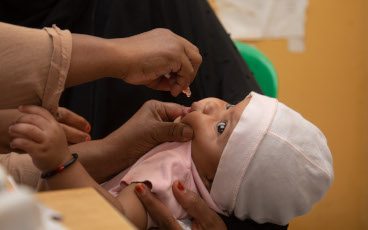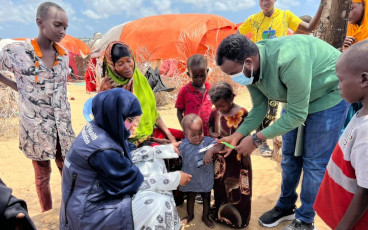Looking Back on 2012
The fewest cases, in the fewest places – with the ultimate sacrifices
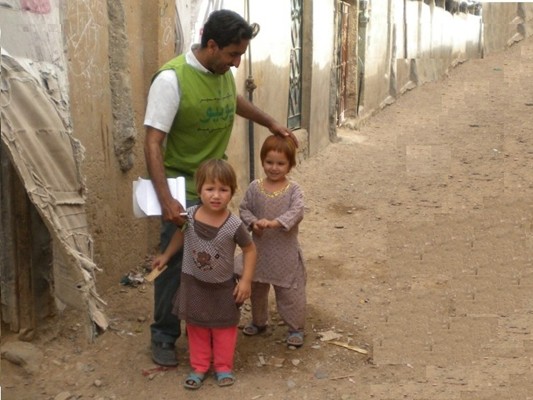
“Are we seeing [polio’s] last stand?” asks the Independent Monitoring Board in their latest report. With the tremendous progress achieved in 2012, they certainly aren’t the only ones asking that question.
The year ended with the fewest children paralyzed by polio, in the fewest places, in history. Just over 200 cases have been reported so far for 2012 – a greater than 60% reduction from 2011. Over the year, through the tireless dedication of the on-the-ground heroes of polio eradication, more than 2 billion doses of vaccine were distributed to 429 million children around the world. And too many of these heroes gave their lives to reach some of the most vulnerable children in the world with vaccine.
India success sparks an emergency to finish the job
2012 was the year that India was removed from the list of polio-endemic countries. Angola and the Democratic Republic of the Congo both put a stop to re-established polio transmission.
The year began with a shake-up of the way the Global Polio Eradication Initiative (GPEI) was structured and does business. The partner organizations shifted into emergency mode from the get-go, looking to become faster, smarter and more innovative in getting the polio vaccine into the mouths of every last child. Accountability was a key focus across the board – from the heads of the spearheading partner organizations, down to the vaccinators in the field. And processes were put in place to ensure greater cooperation, not only between organizations, but between country-, regional- and head- offices.
This shift into emergency mode was formalised when the 194 Member States of the World Health Assembly, meeting in Geneva in May, declared the completion of polio eradication a “programmatic emergency for global public health”. This declaration announced that the global community was committed to ending this disease, and granted countries greater powers to prevent its spread.
Risk of international spread still real
Member States also called for the GPEI’s funding gap to be filled – something which has only just been achieved for 2012 with thanks to a number of traditional and new donors. Throughout the year, the increasing risk of a polio outbreak made many uneasy, as vaccination rounds were scaled back or cancelled as a result of this lack of funds, leaving more children needlessly vulnerable to polio in high-risk areas. The year closed with a new outbreak, in Niger – a reminder of the human cost of spreading poliovirus. If the funds can’t be raised to cover the costs of eradication and prevent further spread in 2013 and beyond, we run the risk of a polio resurgence. With so much progress made, there is all the more to lose.
Progress – and the path to success
A key factor in the progress in 2012 has been enhanced country ownership. All three remaining endemic countries – Nigeria, Pakistan and Afghanistan – implemented their own emergency action plans and introduced oversight mechanisms at the highest levels of government (such as the Presidential Task Force in Nigeria). The full force of administration was put into the effort – going beyond the health sector to a whole-of-society approach. This approach and intensity needs to be sustained to deliver ultimate success.
Strong commitment from the top levels of the Global Polio Eradication Initiative spearheading partners and unflinching support throughout the year from the UN Secretary-General, the UN Foundation and the Bill and Melinda Gates Foundation was critical to the progress seen in 2012.
In a historic display of solidarity at the UN General Assembly in September, leaders from around the world – including the heads of state from Afghanistan, Nigeria and Pakistan, donor government officials and new donors from the public and private sector – vowed to capitalize on progress achieved in 2012 and to step up the fight to eradicate polio. Days after, millions watched the web cast of a concert in New York’s Central Park to catalyze citizen action against polio.
Technical and programmatic innovation played a lead role in 2012, with GPS technology making a difference in ensuring that vaccination teams reach every child. The introduction of a direct disbursement mechanism in Pakistan ensured that health workers were paid directly and on time. Delegations from India to the remaining endemic countries helped transfer vital knowledge about micro-planning, accountability, strategies for special populations, and data collection.
All this paid off in more children being reached in the sanctuaries of the poliovirus. Nigeria was the only country which saw an increase in cases – and even there, more children were being reached with vaccine in the latter half of 2012 than in the first half.
Unacceptable loss
Tremendous sacrifices are being made to reach these children. Polio workers in Pakistan and Afghanistan lost their lives this year while working to protect children against polio. In Pakistan, a unacceptable and horrifying series of attacks on health workers brought the year to a tragic close. Their loss highlights the dedication and bravery of those who risk their lives so that the children in their community live their lives free of polio. Parts of all three endemic countries remain off-limits at the end of the year, but through the ongoing negotiations of partners we continue to reach more and more children, including around 30,000 children living in the Tirah Valley of Pakistan who were vaccinated in 2012 for the first time in three years.
Eradication – and endgame
So what’s next? The partnership is working on distilling the lessons learned from 25 years of polio eradication, including from India’s successful programme, into a plan to end polio and make sure it stays ended. Known as the “Polio Eradication and EndGame Strategic Plan 2013-18”, it sets out a blueprint for ceasing the transmission of both wild poliovirus and vaccine-derived poliovirus, providing support for strengthening routine immunization coverage in key target countries, provides for the safe containment of any poliovirus in laboratories and lays out a roadmap to ensure that the infrastructure put in place to fight this disease can be used to support other health interventions and services. In a historic decision, the Strategic Advisory Group of Experts on immunization called for a globally synchronized withdrawal of type 2-containing OPV – necessitating a switch from tOPV to bOPV in routine immunization programs.
Now that India has laid to rest the argument about whether polio eradication is technically feasible, and new emergency approaches are showing impact, this is the time for everyone to double our efforts, including the international development community. Everything is in place to secure a polio-free world, but without the funds to do so it won’t happen. On one side of the balance, a world free of polio where no child will ever know the pain of polio paralysis, and US$50 billion in economic benefits; on the other, resurgence of the disease resulting in 200,000 cases every year, within 10 years. All countries will benefit equally from global success. Ensuring that success is a global responsibility.


